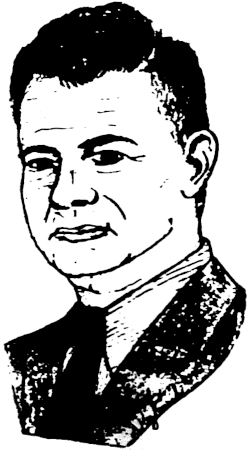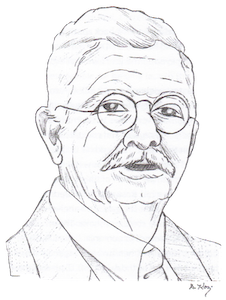Of all the people in Milford’s long history, few have physically affected the community more than Newman E. Argraves - civil engineer and consulting engineer.
Abraham A. Ribicoff, Connecticut’s incumbent governor, opened the Connecticut Turnpike on January 2, 1958, at Greenwich and then led a motorcade through towns and cities including Milford to a similar event in Killingly, CT, on the Rhode Island line.
Four years previous in 1954, design began on the Connecticut Turnpike, the interstate highway that would cut Milford in half. The design would be overseen by Argraves, who served as the Connecticut State Highway Commission at the time - on the I-95 project that was the state’s largest public works effort to that time.
Speaking publicly, Gov. Ribicoff emphasized the “immense benefit” to the state as well as the “most modern highway construction methods contributing to safe driving that have been engineered into this road.”
Ribicoff took special notice to commend Argraves for “meeting an impossible timetable” and to complete the “road of national importance” on schedule.
Argraves had earned the praise.
Interrupting his work on the turnpike were twin hurricanes that ravaged Connecticut in 1955. In the aftermath of the great flooding, Ribicoff was everywhere. Argraves was too, as he was the person actually tasked with destroying all the road connections, temporary bridges, debris clearance, etc. to restore commerce and daily life after the flood damaged and divided entire sections of the state.
Argraves got both done.
At the time of its debut, the Connecticut Turnpike was widely regarded as serving a longer stretch of urban and suburban communities than any other modern expressway in the U.S.
Argraves designated seven exits for Milford, more than any other city, with two more in Stratford serving Devon and one in Orange serving the Live Oaks and Woodmont sections of Milford.
Completion of the highway changed Milford’s growing farm town forever. Retail, commercial, internationally known corporations, and vast residential development came quickly after the turnpike, bringing vast increases in the population and our tax base. Just over a year had passed after the turnpike opened - Milford became a city in 1959.
Perhaps less popular around the region and state was Argrave’s instrumental involvement in excepting Connecticut from some tolls restrictions of Federal Highway Act of 1921, and incorporating pre-existing roadways like the Baldwin Bridge (Saybrook) into the Connecticut Turnpike.
Argrave’s testimony to the U.S. Senate on June 23, 1955, just weeks before the hurricanes of 1955, was instrumental in saving Connecticut millions in 1950s dollars for road development.
The resulting change in the law he advocated for allowed states to “repay” the federal government for existing state dollars received on its roads by tolls. The repayment would then be added on to on top of the “regular” federal “free highway money” allotment to be designated for yet more state road construction.
One can’t blame Newman Argraves for that because that’s how government works. He does deserve credit for helping Connecticut get more than its share in federal highway dollars.
On the downside, Milford was hemmed in by toll stations on three sides for decades including the Stratford and West Haven tolls on I-95 and those on the Rt. 15 - until tolls were abolished after the collapse if the Mianus River Bridge and the Stratford toll crash, in 1983.
When 95-year-old son was appraised of his father’s potential addition to the Milford Hall of fame, he could only add, “He was a great man.”
Argraves engineered, surveyed and designed many Milford projects but also broke new ground. He may have been the first to recommend field inspections via radiographic and/or magnetic particle methods.
He also pioneered the first use of entraining concrete (Aircrete) for the buildings and grandstands at Monmouth Raceway (NJ).
He literally wrote the book on infrastructure flood recovery, authoring Connecticut Highways and the 1955 © 1958 for the American Society of Civil Engineers.
He was a member of many professional, regional and national associations and committees, including being named the 1956 Connecticut Engineer of the Year, Chairman of the Emergency Planning Committee advising the US Bureau of Public Roads (“BPR” - pre-FEMA) and as Consultant to the Executive office of the President of the United States, D. D. Eisenhower, on public works planning.
Argrave’s list of projects are too long to mention. Among his many skills: design and construction of water supply, sewerage, environmental protections, dams and flood control, power stations, airports, schools, office and residential buildings, factories, roads and bridges and more.
Notable projects include Reynolds Alloys (aluminum) plant and facilities., the UCONN stadium and auditorium, and the U.S. Navy ammunition and related facilities in Hingham, MA.
While most of his post-WWII life’s work was in Connecticut and the Northeast, he also designed, built, oversaw and consulted as far away as Washington State and the country of Paraguay.
His early work included industrial, mechanical, electrical, structural and architectural design, construction and operation at Stone & Webster Engineering Corporation and at Haller Engineering Associates from 1935 to 1944, giving him exceptionally broad skill sets.
Newman was twice married. Clara Durepo Argraves gave him two children: Lawrance “Larry” Argraves, who worked with his father as an architect at the Old Gate Lane, Milford firm, and daughter, Janice Fitzgerald.
His second wife was Barbara Velmure Argraves, A daughter through that marriage, Nancy Drummond, worked as a surveyor for her father and continued to live in his Hamden home for many years.
He was the son of James Edward and Annie Walton Argrave, who hailed from Caribou, Aroostook County, Maine.



